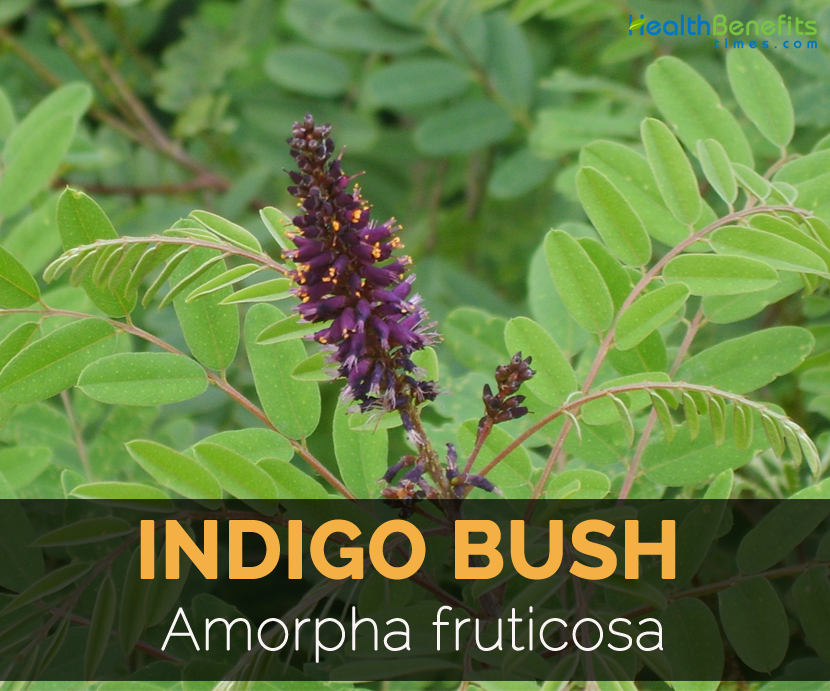| Indigo Bush Quick Facts | |
|---|---|
| Name: | Indigo Bush |
| Scientific Name: | Amorpha fruticosa |
| Origin | Native to the Great Plains |
| Shapes | Small, warty kidney shaped pod |
Native to eastern United states, it is found in all adjacent states and considered intrusive in the Western states. This perennial species of legume reproduces by seeds. The shrub has firm woody branches which terminate in the current season’s growth of hairy and green twigs. Medicinally, it is used for treating various health ailments such as nervous disorders, epilepsy, bronchitis, asthma, stomach pain, fever, kidney and spleen diseases, liver diseases, wounds, sores, skin conditions, gonorrhea, hemorrhoids, snake bites and syphilis. The plant is used as a green manure and cover crop. The plant seeks for full sun to partial shade having medium to dry soil and does not blooms in acidic soil.
Roots
It has extensive root system and grows from proliferating lateral root sprouts. Roots have symbiotic relationship with soil bacteria that forms nodules on roots and has ability to fix atmospheric nitrogen.
Stems
Shrubs have erect, multiple which grows 3.3 to 13 feet high and are commonly branched near the tips. It has open crown of many stems which are unarmed.
Leaves
Leaves are compound, deciduous and arranged alternately on stems. Leaves occur primarily on upper third of the stems. The petioles are 2 to 5 cm long. Leaves are finely hairy or almost hairless, gland dotted. Leaves are 7 to 20 cm long and leaflets are apiculate, oblong to elliptic and green to gray-green. Midrib of leaflet ends in a thin hair like projection which is 0.5 to 1.5 mm long.
Flowers
Flowers form in dense racemes, solitary or in clusters. Calyx is gland dotted and about 2.5 to 4 mm long. Flowers have one petal, lacks wings and a keel. Petal curves around a single pistil and 10 stamens, violet-blue to purple and about 0.2 to 0.24 inches (5 to 6 mm) long. An inflorescence is a raceme of spike shaped of many flowers with a single purple petal and ten protruding stamens with yellow anthers. Fruit is a legume pod that contains one or two seeds.
Fruit
Fruit is a pod which is gland doted, glabrous and short pubescent. Pods are incurved distally measuring 0.2 to 0.4 inches long by 0.06 to 0.16 inches wide and contain one to two seeds.
Medicinal uses
- It is used to treat nervous disorders, epilepsy, bronchitis, asthma, liver diseases, stomach pain, fever, kidney or spleen diseases, wounds, sores, skin conditions, syphilis, gonorrhea, hemorrhoids and snake bites.
- Infusion made from leaves is helpful for nervous disorders, epilepsy, bronchitis, asthma, fever, stomach complaints, kidney and spleen.
- Apply the leaves externally (as an ointment) for treating skin diseases, sores, wounds, hemorrhoids and ulcers.
- In India, seed tincture is used to kill lice.
- Apply the root preparation to provide relief from syphilis, toothache, kidney stones and gonorrhea.
- Use the root infusion as antidote for snakebites and for treating insect and scorpion stings.
- Ingest in form of cold tea to halt vomiting.
- Chew the root to soothe toothaches.
- Use the stem as a wash for treating small pox and other skin problems.
References:
https://www.nrcs.usda.gov/Internet/FSE_PLANTMATERIALS/publications/mopmcfs5865.pdf
https://pfaf.org/user/Plant.aspx?LatinName=Indigofera+tinctoria
http://heritagegarden.uic.edu/false-indigo
https://www.nwcb.wa.gov/images/weeds/Indigo_bush.pdf
http://www.herbgarden.co.za/mountainherb/herbinfo.php?id=427
Comments
comments
